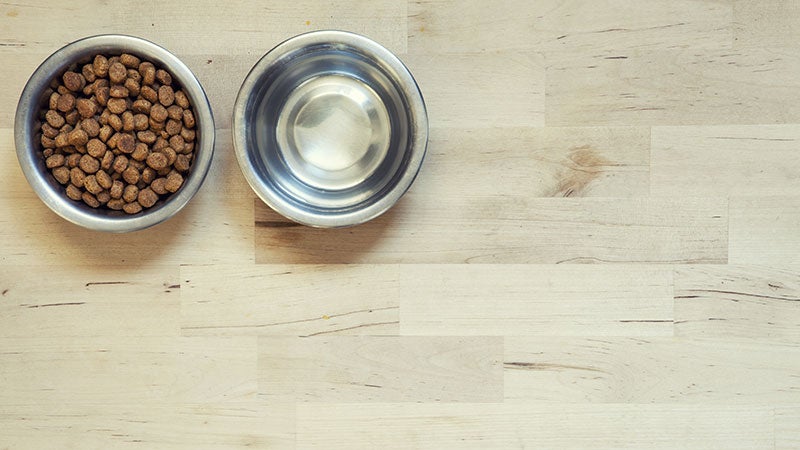There is a lot of information online about what you should and shouldn’t feed your cat. So much information, in fact, that it can get confusing. This guide provides information about what you should know when feeding your cat.
What cats eat
Cats are carnivores, so they need a source of animal protein to be in optimal health. You’ll need to find a high-quality commercial cat food appropriate for your cat’s age and health. If necessary, speak to your veterinarian before you choose what to feed your cat as they can assess their health status as well as ensure you’re feeding them the right kind of food.
Cats will never survive or thrive on a vegan diet. They must have meat to get the nutrients they require.
While it’s perfectly acceptable to feed your cat a commercial dry or wet food, you can offer variety in your feline’s diet by feeding it cooked or raw, fresh meat.
Many cat’s love fish; however, it is not an acceptable food for daily feeding. Fish contains high levels of fatty acids, which can lead to a vitamin E deficiency in cats and painful conditions.
How much food your cat needs
The amount of food your cat needs will depend on its weight, size and age, so don’t always go by what your neighbour is feeding their cat! Obesity is quite common in cats and can contribute to a shorter life span, so always make sure you’re feeding your pet the correct amount of food.
If in doubt, always ask for advice from your veterinarian. Regardless of your cat’s age, always ensure it has access to clean drinking water.
Food in relation to your cat’s age
Kittens
It’s crucial to feed your kitten the correct diet at this time, because it’s still growing its bones and joints.
The basis of your kitten’s diet should be a high-quality, balanced, premium commercial kitten food; however, you can offer cooked or raw meats for variety.
Avoid feeding raw meat until the kitten is at least 20 weeks of age, as their immune system isn’t robust enough for potential pathogens. Strips of raw beef can help remove plaque from your kitten or older cat’s mouth.
Importantly, never feed your kitten cooked bones. These may splinter and cause internal damage or obstruct the intestinal tract.
It’s also a good idea to include some moist foods in your kitten’s diet. Wet canned food or cooked meat is a good starting point. Moist food has been found to help promote urinary tract health.
In terms of the best amount of food for your kitten, it comes down to size, weight, breed and overall health status, so always check with your veterinarian. Kittens should generally be offered food at least four times per day. Of course, they may not wish to eat all of this, but the offer should always be there.
Adult cats
Similar to kittens, the basis of your adult or senior cat’s diet should be a high-quality, premium commercial cat food. when shopping, check the package label to see what age the food is suited to. If you’re ever in doubt or need some help, your veterinarian will be able to assist.
As with kittens, feel free to offer your cat a variety of food such as fresh or cooked meat or fish. Meaty bones or fresh meat is a great source of protein, just make sure it’s human-grade as some pet meat and bone products may contain preservatives that can be harmful for your cat.
Senior cats
Always recognise older cats may have health issues the wrong diet can adversely affect. Many benefit from a wet diet that’s canned, fresh or cooked to help increase the amount of fluid they consume. Always consult your vet about an appropriate diet if your cat has health issues.
In terms of how many servings, it will depend on your cat’s size and age, but always take care when finding the balance between overfeeding and underfeeding. Adult cats generally prefer to eat smaller meals throughout the day, so offer it food at least three or four times. Eating smaller, more frequent meals has been associated with better urinary tract health.
When in doubt, speak to the experts. Your veterinarian will be able to help you answer any questions you may have relating to the type of food and how much to feed your cat.

Foods to avoid feeding your cat
This list is by no means the full extent of what your cat shouldn’t eat. But keep these common foods in mind whenever you’re putting food in its bowl or dropping scraps from the table, as there are some that are highly poisonous for your feline friend.
Foods to avoid include:
- Raisins/sultanas
- Grapes
- Chocolate
- Onions
- Coffee or caffeinated products – caffeine isn’t just found in tea and coffee, it’s also in cocoa, chocolate, cola and stimulant drinks. It can also be found in some cold medicines and painkillers, so never ever leave these lying around
- Bread dough
- Avocado
- Nuts
- Fruit stones – for example, mango seeds or apricot pips
- Fruit seeds
- Corncobs
- Tomatoes
- Mushrooms
- Milk and other dairy products – this one seems strange, because you so often see kittens snacking on a bowl of milk. But don’t be fooled, most cats are actually lactose intolerant.
Cooked bones are a most definite no-no, as is fish every day of the week. While cats do love a healthy serving of their swimming buddies, it’s best fed as a treat every now and then. And when it is fed, tinned sardines, tuna or salmon are your best bet. Just make sure they’re tinned in spring water, and always watch for bones.
Being careful with your cat’s diet is essential to their health, so it should be an area of care for all cat owners. If in doubt about what to feed your feline friend, speak with your veterinarian for more information.
If your cat snacks on something it shouldn’t, pet insurance is one way you can ensure they get the professional help they need along with a financial helping hand for vet bills. RSPCA Pet Insurance for cats is affordable and flexible, with first year of premiums helping support the RSPCA.
29 May 2018
